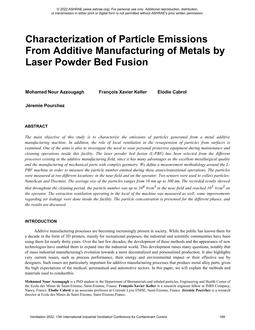Click here to purchase
The main objective of this study is to characterize the emissions of particles generated from a metal additive manufacturing machine. In addition, the role of local ventilation in the resuspension of particles from surfaces is examined. One of the aims is also to investigate the need to wear personal protective equipment during maintenance and cleaning operations inside this facility. The laser powder bed fusion (L-PBF) has been selected from the different processes existing in the additive manufacturing field, since it has many advantages as the excellent metallurgical quality and the manufacturing of mechanical parts with complex geometry. We define a measurement methodology around the L- PBF machine in order to measure the particle number emitted during these annex/transitional operations. The particles were measured at two different locations: in the near field and on the operator. Two sensors were used to collect particles: NanoScan and Discmini. The average size of the particles ranges from 10 nm up to 300 nm. The recorded results showed that throughout the cleaning period, the particle number was up to 104 #/cm3 in the near field and reached 105 #/cm3 on the operator. The extraction ventilation operating in the local of the machine was measured as well; some improvements regarding air leakage were done inside the facility. The particle concentration is presented for the different phases, and the results are discussed.
Product Details
- Published:
- 2022
- Number of Pages:
- 8
- Units of Measure:
- Dual
- File Size:
- 1 file , 1.3 MB
- Product Code(s):
- D-IIVC2022-C025
- Note:
- This product is unavailable in Russia, Belarus
